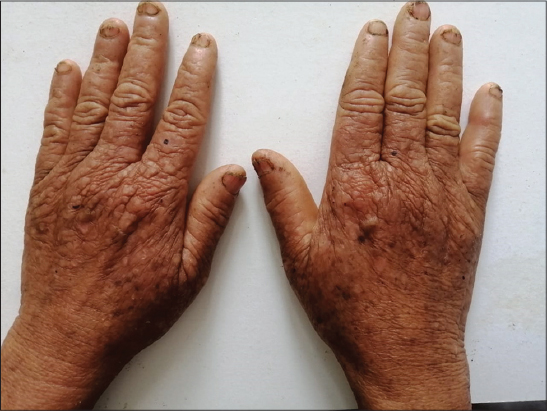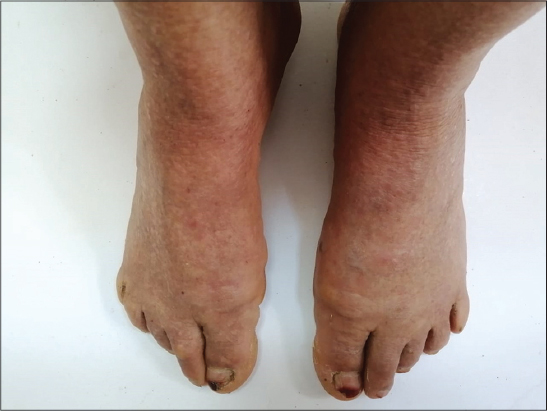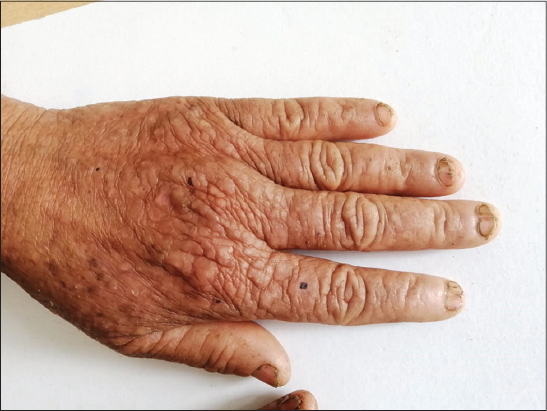Warty papules on the hands and feet: Acrokeratosis verruciformis of Hopf
Refka Frioui , Mariem Tabka, Sana Mokni, Azza Ghanem, Nedia Fetoui, Amina Ounallah, Colandane Belajouza, Mohamed Denguezli
, Mariem Tabka, Sana Mokni, Azza Ghanem, Nedia Fetoui, Amina Ounallah, Colandane Belajouza, Mohamed Denguezli
Department of Dermatology, Farhat Hached Hospital of Sousse, Sousse, Tunisia
Corresponding author: Refka Frioui, MD
How to cite this article: Frioui R, Tabka M, Mokni S, Ghanem A, Fetoui N, Ounallah A, Belajouza C, Denguezli M. Warty papules on the hands and feet: Acrokeratosis verruciformis of Hopf. Our Dermatol Online. 2022;13(2):215-216.
Submission: 29.07.2021; Acceptance: 16.10.2021
DOI: 10.7241/ourd.20222.25
Citation tools:
Copyright information
© Our Dermatology Online 2022. No commercial re-use. See rights and permissions. Published by Our Dermatology Online.
A 47-year-old female was referred to our department because of skin-colored lesions located mainly on the dorsum of the hands and feet. The patient had no diseases and had not taken continuous medication. The lesions were present at birth and had increased in number since then. Four more members of the family, including the mother and the uncle (mother’s brother), had similar skin lesions. A dermatological examination revealed multiple flesh-colored, flat-topped papules, about 2–5 mm in size, which were reminiscent of flat warts on the dorsum of the hands and feet (Fig. 1). A nail examination revealed thickened nails with V-shaped nicks at their free margins on the fingers of both hands (Fig. 2). The patient declined skin biopsy. We retained the diagnosis of acrokeratosis verruciformis of Hopf (AVH).
AVH is a rare inherited disorder of keratinization caused by an abnormal ATP2A2 gene [1,2]. Familial cases indicate an autosomal dominant pattern of inheritance, yet sporadic cases of the disease have also been reported [2]. It is characterized by multiple asymptomatic, flat-topped, skin-colored papules on the dorsum of the hands and feet. Other features may include pits on the palms and soles and nail dystrophy (pearly white nails or nails with longitudinal ridges and nicks in the free edge) [3]. AVH is diagnosed clinically, which becomes easier if there are family members with similar skin findings. Sometimes, a skin biopsy is performed to assist the diagnosis. The key features on histology are hyperkeratosis, hypergranulosis, acanthosis, papillomatosis, and circumscribed epidermal elevations known as church spires, which are a distinctive finding [1,2].
Consent
The examination of the patient was conducted according to the principles of the Declaration of Helsinki.
The authors certify that they have obtained all appropriate patient consent forms, in which the patients gave their consent for images and other clinical information to be included in the journal. The patients understand that their names and initials will not be published and due effort will be made to conceal their identity, but that anonymity cannot be guaranteed.
REFERENCES
1. Bazouti S, Zerrouki N, Dikhaye S, Zizi N. Acrokeratosis verruciformis of Hopf. Our Dermatol Online. 2019;10:93.
2. Duman H, Oguz Topal I, Cak?r C. Acrokeratoelastoidosis and focal acral hyperkeratosis:Report of two cases. Our Dermatol Online. 2017;8:293-5.
3. Brzezinski P, Martini L. Usage of unsaturated esters of retinol to defeat Hopf’s acrokeratosis verruciformis in hands and feet of a young man. Our Dermatol Online. 2018;9:339-40.
Notes
Source of Support: Nil,
Conflict of Interest: None declared.
Request permissions
If you wish to reuse any or all of this article please use the e-mail (brzezoo77@yahoo.com) to contact with publisher.
| Related Articles | Search Authors in |
|
 http://orcid.org/00000-0001-9441-2070 http://orcid.org/00000-0001-9441-2070 |






Comments are closed.